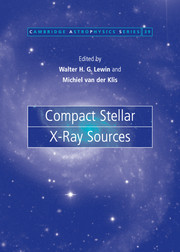Book contents
- Frontmatter
- Contents
- List of contributors
- Preface
- 1 Accreting neutron stars and black holes: a decade of discoveries
- 2 Rapid X-ray variability
- 3 New views of thermonuclear bursts
- 4 Black hole binaries
- 5 Optical, ultraviolet and infrared observations of X-ray binaries
- 6 Fast X-ray transients and X-ray flashes
- 7 Isolated neutron stars
- 8 Globular cluster X-ray sources
- 9 Jets from X-ray binaries
- 10 X-rays from cataclysmic variables
- 11 Super-soft sources
- 12 Compact steller X-ray sources in normal galaxies
- 13 Accretion in compact binaries
- 14 Soft gamma repeaters and anomalous X-ray pulsars: magnetar candidates
- 15 Cosmic gamma-ray bursts, their afterglows, and their host galaxies
- 16 Formation and evolution of compact stellar X-ray sources
- Author index
- Subject index
10 - X-rays from cataclysmic variables
Published online by Cambridge University Press: 01 September 2009
- Frontmatter
- Contents
- List of contributors
- Preface
- 1 Accreting neutron stars and black holes: a decade of discoveries
- 2 Rapid X-ray variability
- 3 New views of thermonuclear bursts
- 4 Black hole binaries
- 5 Optical, ultraviolet and infrared observations of X-ray binaries
- 6 Fast X-ray transients and X-ray flashes
- 7 Isolated neutron stars
- 8 Globular cluster X-ray sources
- 9 Jets from X-ray binaries
- 10 X-rays from cataclysmic variables
- 11 Super-soft sources
- 12 Compact steller X-ray sources in normal galaxies
- 13 Accretion in compact binaries
- 14 Soft gamma repeaters and anomalous X-ray pulsars: magnetar candidates
- 15 Cosmic gamma-ray bursts, their afterglows, and their host galaxies
- 16 Formation and evolution of compact stellar X-ray sources
- Author index
- Subject index
Summary
Introduction
Cataclysmic variables (CVs) are a distinct class of interacting binaries, transferring mass from a donor star to a degenerate accretor, a white dwarf (WD). In all observational determinations, and as is required by theory for stable mass transfer, the donor star is of lower mass than the accretor. For comprehensive overviews on the subject of CVs we refer to Hack & La Dous (1993) and Warner (1995).
The majority of CVs have orbital periods, Porb, between 75 min and 8 h (see Ritter & Kolb 2003) and consist of Roche lobe-filling main sequence donors and WDs. These are WD analogues of the low-mass X-ray binaries (LMXBs; see Chapter 1). In the period range 8 h–3 d the donors must have larger radii than dwarfs in order to fill their Roche lobes and are therefore evolved subgiants. A few CVs are found with Porb ∼ 200 d, which require giant donors for them to be lobe-filling. The absence of evolved CVs with periods ∼3 to ∼200 d is connected with the dynamical instability that results from an initial donor that had a mass larger than about 67% of that of the WD; such binaries will have experienced rapid mass transfer and shortened their periods during a common envelope phase (e.g., Iben & Livio 1993; see also Chapter 16). Beyond Porb ∼ 200 d, mass-transferring systems also exist.
- Type
- Chapter
- Information
- Compact Stellar X-ray Sources , pp. 421 - 460Publisher: Cambridge University PressPrint publication year: 2006
- 34
- Cited by



